ASUS UL80Vt First Look: Mobility Redefined
by Jarred Walton on October 24, 2009 8:00 PM EST- Posted in
- Laptops
ASUS UL80Vt Benchmarked - General Performance
This is a first look and we have not yet had a chance to run all of our performance tests. Battery life testing in particular is going to take a long time -- which is a good thing, outside of the testing aspect. We have only had the UL80Vt for two days now, but we have been duly impressed with its features, design, and performance. It may not be the best-looking laptop on the planet, it may not have every feature under the sun, and it certainly isn't the fastest laptop. However, it does everything a typical laptop user could need, it does it at an affordable price point, and it truly manages to redefine what we can expect in terms of mobility from Windows laptops. Here are a few preliminary benchmarks we've run.
We conducted tests using the "moderate battery saving" and "maximum performance" profiles in ASUS' Power4Gear software. Turbo mode (overclocking) was enabled in all testing so far; honestly, we don't see much point in disabling it (which requires a reboot), but we'll test battery life without Turbo mode for the full review; that may add another 5-10% battery life, although the laptop already lasts a full day so it's not a critical concern. The SU7300 CPU has two P-states, 800MHz and 1300MHz; the overclocked FSB results in the SU7300 running at 1066MHz or 1733MHz (using a 4X or 6.5X multiplier). CPU-Z does not report clock speeds correctly (it always showed an 8X multiplier for some reason), but ASUS provided an updated version of Intel's Thermal Analysis Tool that reports the correct speed.
After a few initial tests, we discovered that the only way to get the CPU to run at the 6.5X multiplier is to select "Maximum Performance" in the Power4Gear software, with the maximum CPU speed set to at least 62%; otherwise the CPU will always run at the 4X multiplier. Since we already had a bunch of results for 1066MHz, we decided to report those -- it will make for an interesting comparison with the Intel Atom at least. The 1733MHz results will be in bright green and the 1066MHz results are in dark green in the following charts. We'll start with general performance results using PCMark as well as a few CPU intensive tasks like video encoding and 3D rendering.
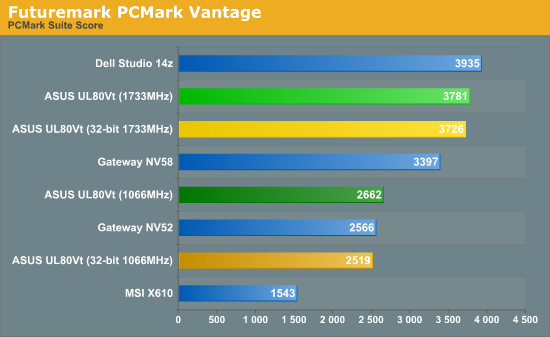
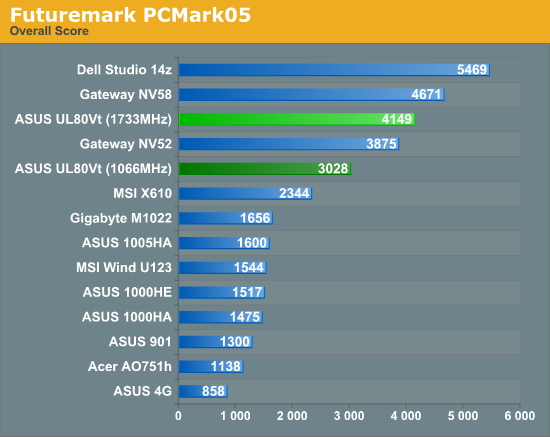
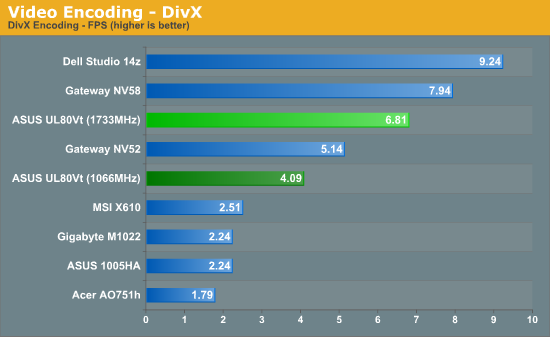
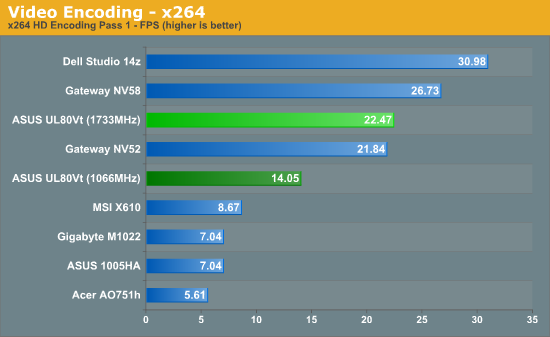
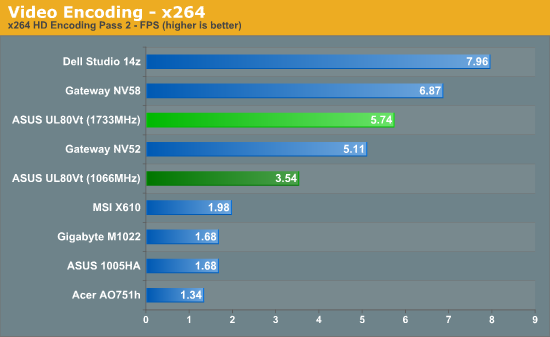
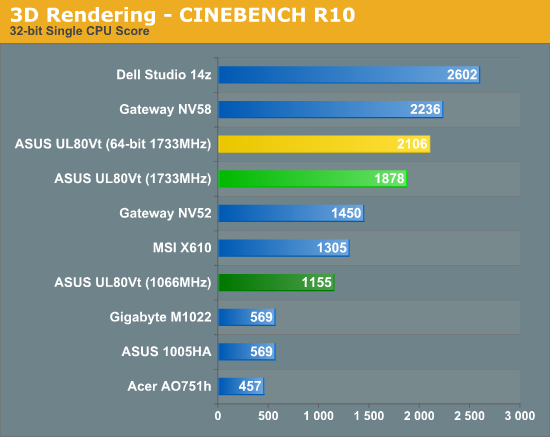
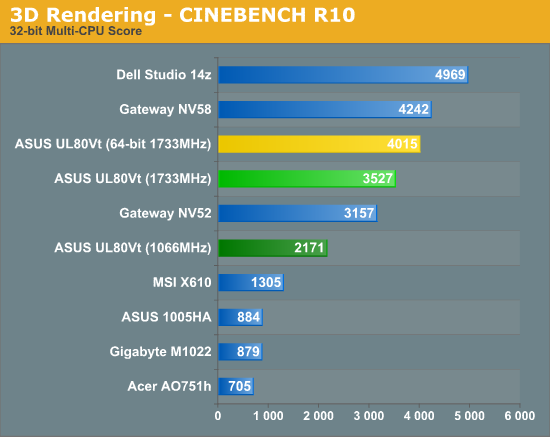
The general performance delivered by the UL80Vt is certainly impressive. It's not the fastest laptop on the market by any means, but application performance is better than the majority of AMD-based laptops currently available. The overclocked SU7300 outperforms the Athlon QL-64 (2.1GHz) by 7% in PCMark05, 47% in PCMark Vantage, 12% in the second x264 encoding pass (the first pass is relatively simple by comparison, depending more on the hard drive and platform than on the CPU), 32% in DivX encoding, and 12% in CINEBENCH R10. The latest 45nm AMD parts like the Turion II Ultra M640 will regain the lead, certainly, but we still have to account for power draw. We'll get to that in a moment, but suffice it to say that it's going to be difficult to beat the overclocked SU7300.
Comparing the UL80Vt to netbooks shows just how slow the Intel Atom is. Even at 1066MHz, the UL80Vt is typically at least twice as fast as the ASUS 1005HA, and at 1733MHz it's 150-250% faster. Sure, it also costs twice as much, but we would make a strong argument that netbooks are only "fast enough" if your demands are low. The bigger selling point for netbooks is their small size and weight, and 14" laptops costing close to $800 certainly encroach on that territory. Netbooks work far better as a second (or third…) PC than as your primary system, while something like the UL80Vt can fill all roles reasonably well. If the general application performance makes netbooks look bad, wait until we look at graphics performance.










100 Comments
View All Comments
MrSpadge - Sunday, October 25, 2009 - link
technique = technology *doh*Alexo - Monday, June 28, 2010 - link
Let me add my vote for:- a matte display
- a good display (*VA or IPS)
- a quality keyboard
I am willing to pay for these features and I am sure others will as well.
tmgp - Sunday, October 25, 2009 - link
"We looked at the ASUS UL50Vt running on Windows 7 Home Basic"Does windows 7 home basic exists?... Don't think so
iamezza - Sunday, October 25, 2009 - link
Windows 7 Home BasicWindows 7 Home Basic will be available in emerging markets such as Bangladesh, Brazil, People's Republic of China, India, Indonesia, Italy, Mexico, Pakistan, the Philippines, and Thailand.[13] It will not be available in countries such as Australia, Canada, France, Germany, Ireland, The Netherlands, United Arab Emirates, Saudi Arabia, New Zealand, the United States, and the United Kingdom.[13] Some Aero options are excluded along with several new features.
MadMan007 - Sunday, October 25, 2009 - link
Why is it called the UL80Vt? If that were consistent with the others in the line it would imply an 18" screen. Wierd..strikeback03 - Monday, October 26, 2009 - link
I though the same thing, did they already use UL40Vt on something?codedivine - Sunday, October 25, 2009 - link
I request benchmarks for new Turion II based laptops. Turion II is 45nm based with Phenom based cores. The Athlon QL-64 used here is 65nm bsed and uses K8 cores.I also request benchmarks for the machine HP dm3. It comes in an AMD flavor and a Intel flavor and in the Intel flavor supposedly provides 10 hours of battery life and on AMD about 5.5.
codedivine - Sunday, October 25, 2009 - link
Also, I specifically request Turion II and NOT Athlon II. Athlon II supposedly only have 64b FP units as opposed to full speed 128b FP on Turion II.feelingshorter - Sunday, October 25, 2009 - link
Can we get battery numbers without turbo mode enabled? I don't see why anyone would turn turbo on unless they know they are doing something specifically CPU intensive. Could you please add that to the chart?JarredWalton - Sunday, October 25, 2009 - link
The whole reason for the "first look" is that battery tests are going at a rate of about one per day. It's the blessing and curse of a long battery life, and I like to be thorough. In the full review, I'll provide some figures for with and without Turbo, as well as battery life with the G210M enabled (with and without Turbo if I've got the time...).From what I can see, the Turbo really only accounts for about a 0.5W-1W increase in power draw, so without Turbo battery life might increase to around 560 minutes for Internet surfing, or best-case about 590 minutes. I think idle power draw isn't affected as much (closer to .25W-.5W increase), so without Turbo idle battery life would be in the realm of 800-840 minutes. Obviously, that's still a HECK of a long time. :) I'll get you numbers in about a week or so when I've finished testing.